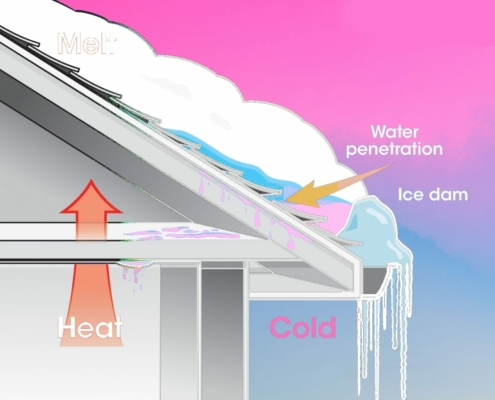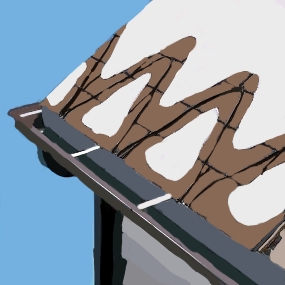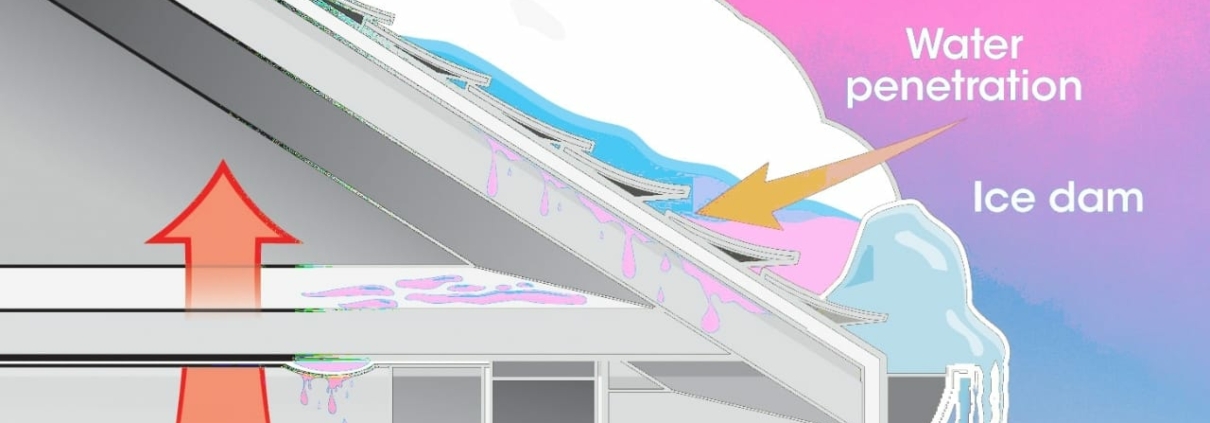Ice Damming
In the winter, when snow falls, there can be many problems; a major one is ice dam formation. When snow accumulates on the roof, the roof becomes more insulated. The combination of this layer of snow along with the heated air inside the home causes the attic to get warmer. As the temperature within the attic increases, warmer air rises up to the roof`s peak and melts the snow. Melting snow and water travel down from the roofs peak it is reintroduced to frigid temperatures near the roof’s lower edges. More and more water freezes at the roof’s edge resulting in the formation of ice dams.

Consequences of Ice Damming
One of the major problems with ice damming is that the roof’s shingles can be severely damaged. Ice dams can cause a lot of weight to be concentrated on the shingles. Snow melting and freezing cause shingles to curl, crack, and even break. As the water freezes and expands, the shingles can be shifted from their position or stripped from the roof entirely. Shingles that are lost or cracked can result in water leaks and subsequent moisture damage to the roof and the home. Furthermore, ice dams can fade away the paint and cause wood rot of the exterior trim and wall covering.
Ultimately, ice damming can decrease the life span of shingles, costing you time and money. Ice damming causes shingle aging to accelerate due to granule loss and mechanical damage. If frequent ice damming results the likelihood and severity of roof leaks increases.
What Causes Ice Dams?
Poor Ventilation
Attic ventilation plays a major role in regulating the temperatures of your attic space and can influence whether ice dams will form. If the attic is not well ventilated and heat is trapped inside the attic, the temperature of the roof decking will rise. This ultimately leads melting snow to roll down the roof edge, and before dripping off, the water refreezes. Continuous layers of melting snow and refreezing of snow cause a thick layer of an ice dams. If, however, the attic is well-ventilated during the winter, any heat that rises into this space effectively dispersed and removed. This reduces the likelihood snow on the roof prematurely melting and refreezing.
Lack of Insulation
The goal is to keep the temperature in the attic as close to that of the outside of the home to prevent the roof decking from warming before the cold weather subsides. Proper insulation goes a long way with helping accomplish this. By minimizing the amount of heat transfer from inside of the home into the attic, the possibly of ice dam formation is greatly reduced. Not to mention, your heating bill will be lower due to less heat loss.
Improper Air sealing
In every home there are air leaks which can exist on any floor. A home can be adequately insulated and still have air leakages that allow warm air to pass from the living space into the attic. These air leaks can warm your roof and lead to ice dams. Because air leaks can be difficult to identify without specialized equipment, its often best to call an expert team that can search through every floor and close the air leaks to avoid heating of the attic during winter months.
Poorly Maintained Gutters
When the snow on the roof melts, its important that water is able to travel through the gutters unimpeded. Problems with this arise mainly when leaves, moss, branches or other debris fill in the drain and blocks the passage of water. If the gutters are blocked the formation of ice dams may begin or become acerbated.
Warning Signs You Should Look For
When notable amounts of snow is melted at the top of the roof yet snow and icicles are present along the lower edges of your roof it is warning sign of ice damming. If you observe changing color of icicles to dark, this could be an indicator that the moisture has made its way beneath the shingles. This occurs as dust is transferred from inside of the home and into the ice.
Formation of icicles can also be a sign that melted water cannot pass through the gutter due to a possible blockage. Finally, staining on the ceiling of your home means that ice and water has made it underneath the roof covering and has begun to saturate the interior surfaces of the home.
Heat Cable for Ice Dam Prevention
We previously covered many factors which can contribute to the development of ice dams on your roof. If addressing these factors proves unsuccessful or impractical, heat cables may be an effective measure to eliminate the formation of ice dams. Heat cables provide electrical resistance and create a path for water and snow on the roof to traverse into the gutters. This is helpful as it stops the water from refreezing at the roofs edge. This does not necessarily mean that the roof edges will be snow free, but they will be free from ice dam formation.

Advised Maintenance for Ice Damming
- It is essential that you call an expert before the winter season to evaluate the roof and repair any areas that may be susceptible to ice and water penetration.
- Consider getting a home energy audit to identify if and where additional insulation may be needed and where air leaks may exist.
- Remove leaves and other possible obstructions to your home’s gutters to promote the flow of snowmelt away from the roof.
- Having heat cables installed can be a good proactive measure to ensure ice dams to not form on your roof. There are many cables on the market, and not every cable system will match your roof design. Consult an expert that can carefully analyze your roof`s need and capacity.
- It is an excellent practice to check the heat cable warranty, which can range from 1-2 years on you roof to systems that exceed 10 years.




